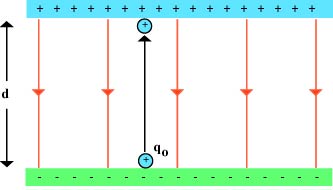
Electric Potential Energy & Electric Potential
Electric Potential Energy
Suppose a small positive test charge, qo is in a uniform electric field created by two oppositely charged parallel plates. If we want to move the test charge from the negative plate to the positive plate at a constant velocity a force would be required to move this test charge from the negative plate to the positive plate at a constant velocity.


This force would result in positive work being done on the test charge. The test charge would gain electric potential energy.
| Work = | Δ Energy |
| Work = | Δ Electric Potential Energy |
| Force · Distance = | Δ Electric Potential Energy |
| qo · Electric Field · Distance = | Δ Electric Potential Energy |
| qo · E · d = | Δ Ue |
Electric Potential Energy due to a Point Charge
If a small test charge, qo is in a non-uniform electric field created by a point charge the electric potential energy change, Δ Ue , is more difficult to calculate. If we want to move the test charge at a constant velocity, a force would be required. However because the electric field varies the force required varies making it more difficult to calculate the work or change in electric potential energy when the test charge is moved. It can be easily understood that when a test charge is close to a positive point charge it has more electric potential energy than when it is farther away or when it is close to a negative point charge.
Electric Potential Difference
The relationship between electric potential difference and electric potential energy is similar to the relationship between electric forces and electric fields.| Electric Field = | Electric Force per Unit Charge |
| E = | F / qo |
| Electric Potential = | Electric Potential Energy per Unit Charge |
|
As has been the case throughout all of our work with energy, it is not really the amount of energy that we are concerned with but rather what is the change in in energy. Therefore we will talk about Electric Potential Differences or Changes in Electric Potential Energy.
|
|
| Electric Potential Difference = | Change in Electric Potential Energy per Unit Charge |
| Electric Potential Difference = | Δ Ue / qo |
| Change in Voltage = | Δ Ue / qo |
| Δ V = | Δ Ue / qo |
Electric Potential Difference due to a Point Charge
For non-uniform electric fields the electric potential difference is a little more difficult to determine. If a small test charge is at position A and then moved to position B, how do we determine the change in Electric Potential Energy. Or if we don't have a small test charge how do we determine the Potential Difference between position A and position B.
| Electric Potential = | Electric Potential Energy per Unit Charge |
| V = | k · q / d |
| Electric Potential Difference = | Change in Electric Potential Energy per Unit Charge |
| Δ V = | (k · q / d)final - (k · q / d)original |
Electric Potential increases (+Δ V) at positions nearer positive charges or farther away from negative charges.
Electric Potential decreases (-Δ V) at positions farther from positive charges or nearer negative charges.
Electric Potential Difference due to many Point Charges
| Net Electric Potential = | Net Electric Potential Energy per Unit Charge |
| V = | V1 + V2 + V3 + ..... |
| V = | (k · q1 / d 1) + (k · q2 / d 2) + (k · q3 / d 3) + ... |